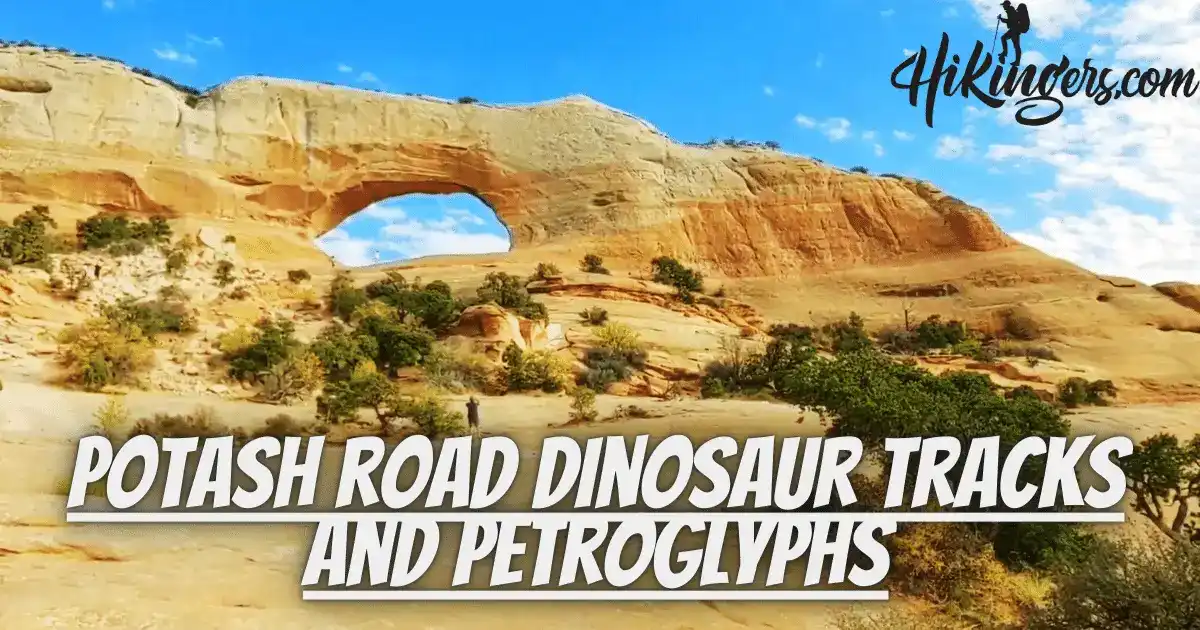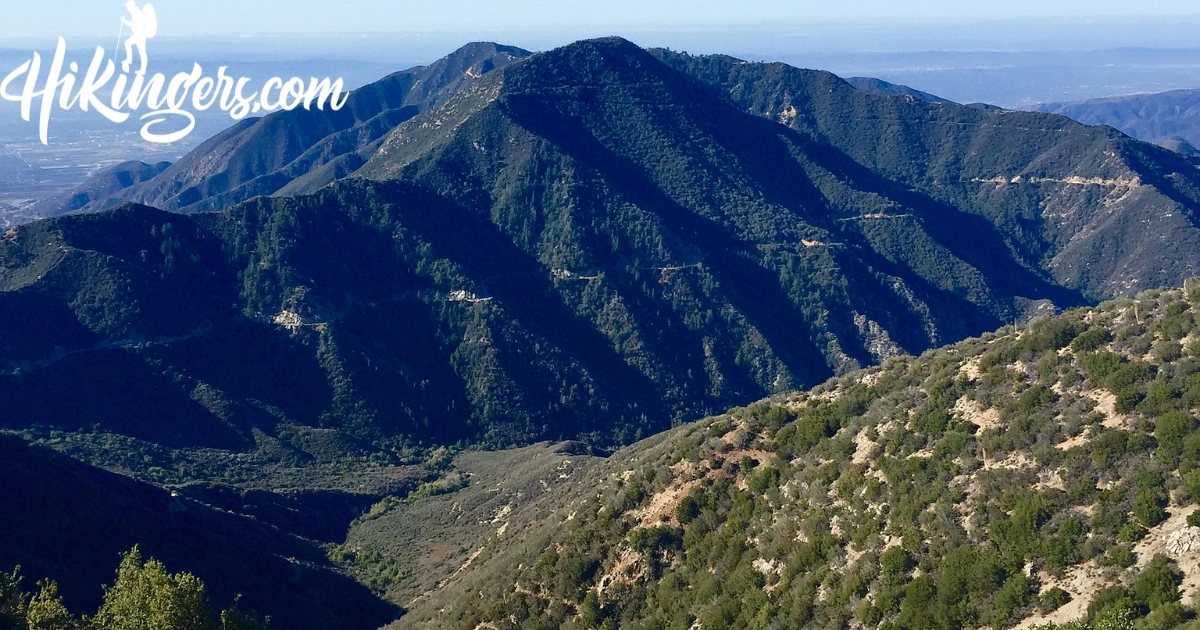Along a remote desert track outside Moab, Utah lies a landscape scattered with pieces of the past. Impressions left by giant reptiles and native peoples reveal snippets of life in ancient times. The Potash Road Dinosaur Tracks and Petroglyphs transport us back through vanished eras to walk alongside lumbering dinosaurs and glimpse the art of early inhabitants. Let’s explore the fascinating history encrypted in stone at this remarkable roadside attraction.
Millions of Years in the Making

100 million years ago during the Early Cretaceous period, Utah looked far different than the arid deserts found today. It was a coastal wetland dotted with tidal pools and deltas, providing perfect stomping grounds for large sauropod dinosaurs.
Prime Dinosaur Habitat
The warm, swampy environment allowed massive long-necked sauropods and other dinosaurs to thrive. Huge herds ambled through the marshes and along shallow shorelines.
Massive Footprints
As the enormous creatures waded through the mud, their wide columnar feet left deep impressions that hardened into stone over time. These become the fossilized tracks we can observe today.
Changing Landscapes
Plate tectonics altered the landscape, with water receding and mountains uplifting. Erosion eventually exposed the buried footprints on today’s desert surface.
A Slice of Deep Time
These 110-160 million year old tracks provide an astounding glimpse into Utah’s prehistoric past and the Jurassic giants that once dominated.
Tracking the Titanic Sauropods

Most of the fossil tracks along Potash Road were left by massive long-necked sauropods. Studying these traces offers insight into the colossal creatures’ existence.
Identifying Species
Track patterns and contours indicate at least two sauropod species traversed the area. Broad-footed apatosaur tracks contrast with more cylindrical diplodocus prints.
Herd Behavior
Groupings of multiple prints heading the same direction reveal how these gigantic dinosaurs often traveled in herds for feeding and migration.
Juvenile and Adult Tracks
Size variations show tracks of full-grown sauropods alongside smaller prints from younger dinosaurs. The area was frequented by dinosaurs of all ages.
Movement Patterns
Measuring stride lengths shows whether dinosaurs were walking casually or moving more quickly. Trackway angles also indicate direction changes.
Prehistoric Snapshots
Footprints plot exact moments in time, preserving fleeting occurrences like a sauropod stopping to scratch or scuffle marks where they slipped in mud.
Petroglyph Gallery Spanning Centuries

Etched into the rock surfaces are also hundreds of intricate petroglyph designs left by Native American tribes dating back over a millennium.
Atlatl Petroglyphs
The most common figures depict atlatls, traditional spearthrowers used for hunting. These carvings honor the tool’s significance for survival.
Ancestral Puebloan Art
Elaborate glyphs in recognizable Ancestral Puebloan styles date to 500-1300 AD when they inhabited the area.
Ute Tribal Symbols
Abstract swirls and shapes match later Ute designs. This shows the Ute people also visited the site after the Puebloans migrated.
Spanning Generations
Superimpositions of older and newer figures showcase how the locale remained a sacred site to native cultures for centuries.
Ceremonial Meanings
While meanings are uncertain, petroglyphs likely held ceremonial significance and were created during rituals.
The Allure of Discovery

The lure of spying ancient traces draws visitors down Potash Road to contemplate the grandeur of prehistory firsthand. Signs marking the main tracksite provide context on the marvels to observe.
Striking Trackway
A large trackway panel of 16 consecutive sauropod prints allows imagining the thunderous footsteps of a dinosaur herd.
Lone Tracks
Isolated prints scattered around the road tell their own stories, like a single sauropod’s side trip to the water’s edge.
Petroglyph Panorama
A cliff wall coated in elaborate overlapping petroglyphs provides a sweeping display of native artistry.
Hands-On Learning
Kids and adults alike will be thrilled to compare their shoe or hand sizes against dinosaur tracks for fun perspective.
Down the Rabbit Hole
Once you spot one track or glyph, your eyes attune tonotice countless more etched everywhere, making discovering each feel like a treasure.
Responsible Tourism

As more people discover these prehistoric sites, it’s crucial visitors follow rules to prevent damage when visiting.
Stay on Trails
Foot traffic around tracks wears down distinct contours. Stick to marked paths to avoid gradually erasing these irreplaceable traces.
No Chalk Rubbings
Rubbing petroglyphs accelerates erosion. Sketching or photographs are safer ways to recreate them.
Leave No Trace
Pack out all trash and belongings to keep the area pristine. Avoid camping or fires near the tracks and glyphs.
Watch Your Step!
Beware loose rock and cliff edges for safety, but take care where you walk or place hands to avoid impact.
Spread Awareness
Though remote, word spreads fast today. Promote responsible tourism when sharing photos so future generations can experience the wonder.
Conclusion
The Potash Road Dinosaur Tracks and Petroglyphs transport us back through the eons to walk with Jurassic giants and witness artistry of ancient native cultures. These traces offer once-in-a-lifetime portals to imagine roaming with Apatosaurus, glimpse Ute ceremonies, or ponder the vast expanse of geologic time. While visiting requires making extra effort to tread lightly, the chance to observe such priceless vestiges of the past is worth protecting. As with dinosaur tracks preserving prehistoric occurrences in stone, our memories likewise imprint moments of discovery, and through our stories, these mementos endure.
FAQs
At Potash Road Dinosaur Tracks and Petroglyphs, what kinds of dinosaur footprints can be found?
Dinosaur footprints from a variety of dinosaur species, including enormous sauropods, quick theropods, and even some uncommon ornithopods, may be seen on Potash Road. These remains reveal important details about the area’s prehistoric inhabitants.
Are there any guidelines for taking pictures at the location of Potash Road Dinosaur Tracks and Petroglyphs?
At the Potash Road location, photography is permitted, but flash photography is not allowed to protect the delicate petroglyphs.
How old are the Potash Road Dinosaur Tracks and Petroglyphs?
Approximately a billion years ago, during the period known as the Jurassic period, dinosaur examines emerged. The age of the petroglyphs has been determined to be in the tens of thousands of years, with certain ones possibly dating back older than 10,000 thousand years.
What places should you visit when visiting Potash Road Dinosaur Tracks and Petroglyphs nearby?
Don’t miss the chance to visit other surrounding sights while you are on Potash Road, including Arches National Park, Dead Horse Point State Park, and the stunning canyons of Canyonlands National Park.
Can I go on a hike along Potash Road to find more petroglyphs and tracks?
Potash Road is an exciting place to hike, but to protect the delicate trails and petroglyphs, visitors are advised to stay in the approved zones. The integrity of the website must be protected, so abide by the rules.
You May Also Like

My name is David James I am an adventurous hiker based in California. Through this weblog, I percentage my passion for exploring nature’s wonders, documenting breathtaking trails and hidden gemstones.



